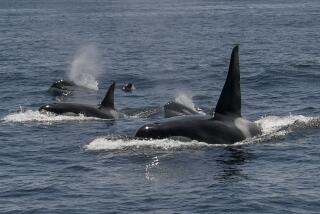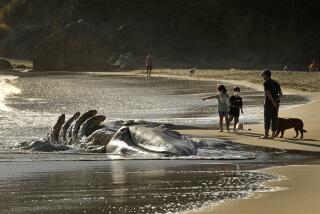Japanese whalers go back on the hunt for ‘science’
Gray whales have embarked on their southbound migration along the West Coast and, thankfully, they aren’t being trailed by meat hunters posing as scientists.
No such luck for cetaceans in the extreme South Pacific, where Japanese whalers aim to harpoon, over the next several months, 935 minke whales, 50 fin whales and 50 humpback whales.
It’s the first legal hunt of endangered humpbacks since an international moratorium was put in place in 1963.
And anyone who believes the expedition is purely for science, as Japan contends, or that humpback whales need to be killed to measure pregnancy rates, might be led to believe the sun rises in the west.
“Only 50 could hugely impact a small breeding population” of any of the many groups of humpbacks that migrate to the area, says Alisa Schulman-Janiger, a researcher with the American Cetacean Society.
Critics say the argument for the expedition is merely a ploy to skirt the international moratorium placed on all commercial whaling in 1986 but which allows hunts that serve a scientific purpose.
There is evidence to support those critics: Japanese whalers sail through the same loophole every year, returning with 50-ton lab specimens that also become table fare for a nation that for generations has savored it.
These hunts, then, may be based more on culture and principle, even though present generations of Japanese appear to have lost the desire for oily, fishy-tasting leviathan.
What does any of this have to do with the Pacific gray whale migration, which will pass the Southland coast over the next several weeks?
Very little. But it may serve as a reminder of our not-too-distant past, when whales of various types, including grays, were slaughtered wantonly by U.S. whalers.
Whaling played a vital role in the growth of America. No species was safe and no region offered refuge.
Hundreds of U.S. ships, carrying exploding harpoons, plied the seas during whaling’s heyday in the mid-1850s.
U.S. whale oil was sold globally as an illuminant and lubricant. It was used to manufacture candles, soap and paint. Baleen from the mouths of whales was used in women’s clothing. Ambergris helped produce fine perfumes.
There were titanic clashes between whales and whaling crews, who pursued the quarry into the icy Arctic and spent weeks or months enduring perilous conditions.
During the Civil War, the Confederacy, hoping to cripple Northern commerce, commissioned the Shenandoah, whose crew captured and burned 25 whaling vessels.
Gray whales were not as prized as larger sperm, right, blue or humpback whales, but they hugged the coast and were easy targets. A North Atlantic population became extinct and the Eastern North Pacific population -- the Pacific, or California grays -- appeared similarly doomed.
This became especially apparent after the discovery, by Capt. Charles Melville Scammon, of a major nursing ground within a Baja California lagoon that now bears his name.
He brought bomb lances with time-delayed fuses, so the explosion occurred inside the mammals. More ships followed and probed other lagoons, turning them red with whale blood.
Scammon eventually quit whaling and in 1874 published a book, “The Marine Mammals of the North-Western Coast of North America.” In it was this passage:
“The mammoth bones of the California Gray lie bleaching on the shores of those silvery waters, and are scattered along the broken coasts, from Siberia to the Gulf of California; and ere long it may be questioned whether this mammal will not be numbered among the extinct species of the Pacific.”
Fortunately, an increasing dependence on kerosene and the discovery of petroleum in Pennsylvania rendered whale oil obsolete and heralded the industry’s imminent demise.
But whaling continued into the 1900s and one of the last U.S. factory ship operations worked off Malibu, targeting gray whales as they passed by Point Dume.
The vessel California and its “killer ships,” the Hawk and Port Saunders, slaughtered at least 250 whales in two years in the mid-1930s.
Emerson Gaze, for an article in the Jan. 30, 1936, edition of the Santa Monica Evening Outlook, spent a day with the fleet and described a hunt:
“The harpooner swings his gun into position. The whale humps over, his back out of the water for a moment. The gunner aims. There is a terrible roar. The entire vessel vibrates. The harpoon finds its mark. A bomb attached to the harpoon explodes inside the mammal, wounding or killing it and opening four large claws designed to ensure a firm hole on the whale.”
Each whale was valued at $1,500, a jackpot during the Depression. Oil was cooked into soap. Meat became dog food and the rest fertilizer.
There remained perhaps only a few thousand gray whales when the International Whaling Commission awarded them protection in 1946.
Today the estimate is between 18,000 and 22,000, well below the 78,000 to 117,000 that existed in pre-whaling days.
Indeed, they remain a precarious lot. Haunting them are new threats, notably climactic changes that are altering their Arctic feeding grounds.
But life goes on and so must the important journey to Mexico. Whales have already been spotted passing Catalina and Palos Verdes, and numbers will grow through December and January.
So will the number of modern-day whalers, armed not with exploding harpoons but with cameras and binoculars. For some, thankfully, there is no need to cling to the past.
More to Read
Sign up for Essential California
The most important California stories and recommendations in your inbox every morning.
You may occasionally receive promotional content from the Los Angeles Times.









